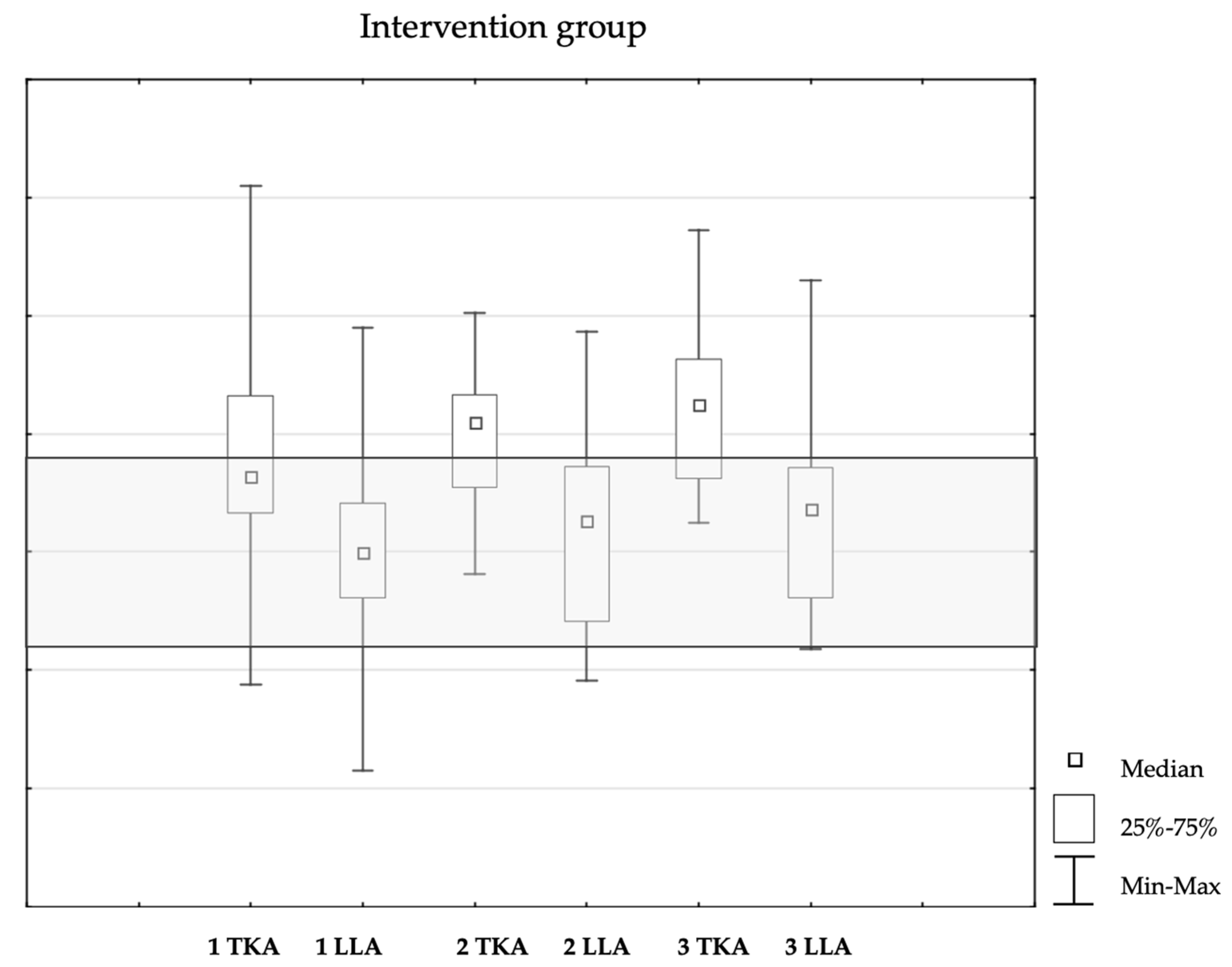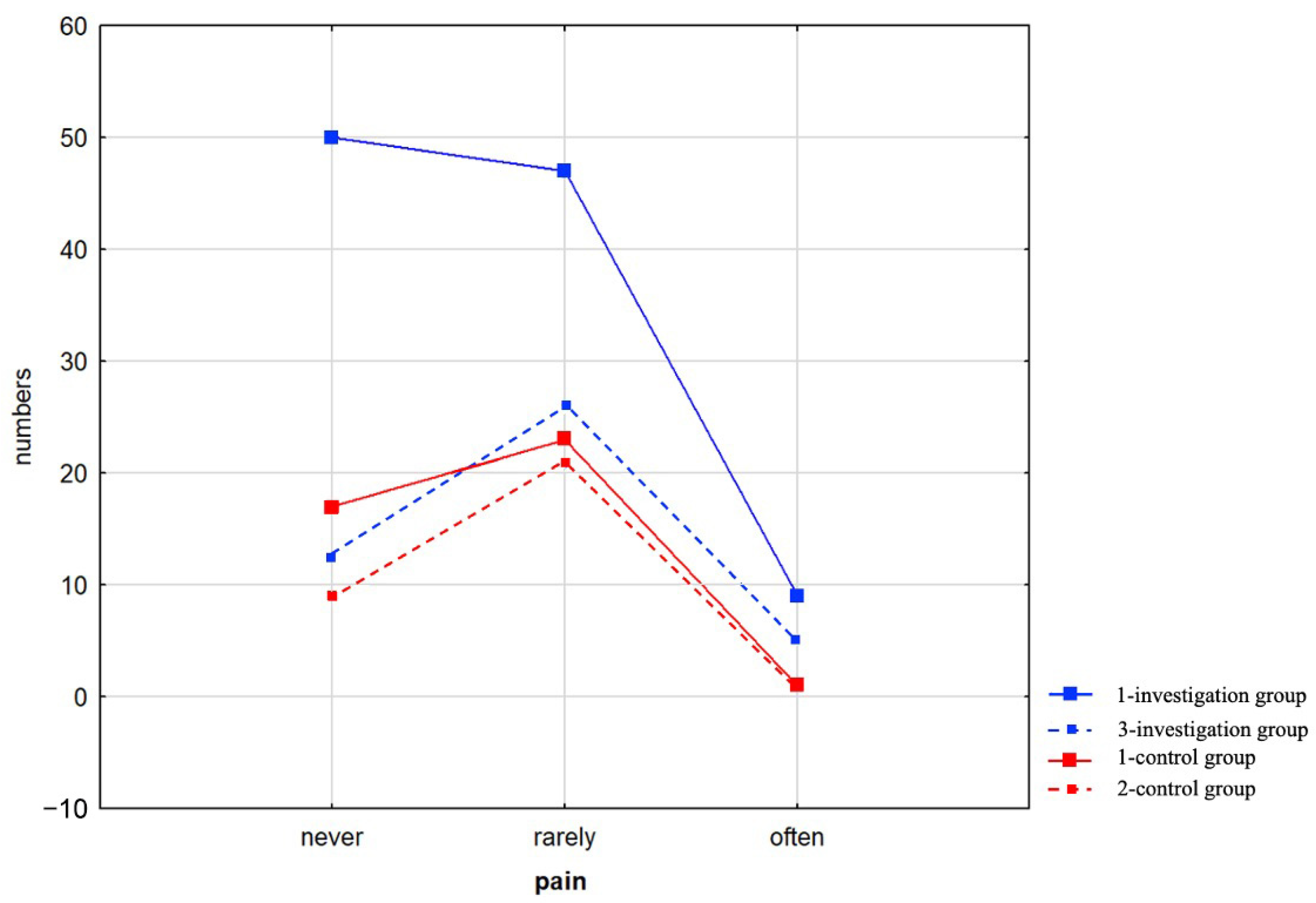The Role of Stabilization Exercise in Preventing Pain and Postural Defects in Young Football Players
Abstract
1. Introduction
2. Materials and Methods
2.1. Bioethics Committee
2.2. Study Participants
2.3. Inclusion and Exclusion Criteria for the Study
2.4. Procedure for Stages I, II, and III in the Intervention Group
2.5. Postural Assessment
2.6. Proprietary Questionnaire
2.7. Proprietary Core Stabilization Training
2.8. Statistical Analysis
3. Results
3.1. Characteristics of Football Training
3.2. Qualitative Analysis of Thoracic Kyphosis Angle and Lumbar Lordosis Angle
3.3. Trunk Rotation: Sum of the Angles of Trunk Rotation (SATR)
3.4. Pain Complaints
4. Discussion
5. Conclusions
6. Limits
Author Contributions
Funding
Institutional Review Board Statement
Informed Consent Statement
Data Availability Statement
Acknowledgments
Conflicts of Interest
References
- Ramos, A.P.; de Mesquita, R.S.; Migliorini, F.; Maffulli, N.; Okubo, R. FIFA 11+ KIDS in the prevention of soccer injuries in children: A systematic review. J. Orthop. Surg. Res. 2024, 19, 413. [Google Scholar] [CrossRef]
- Prieske, O.; Muehlbauer, T.; Borde, R.; Gube, M.; Bruhn, S.; Behm, D.G.; Granacher, U. Neuromuscular and athletic performance following core strength training in elite youth soccer: Role of instability. Scand. J. Med. Sci. Sports 2016, 26, 48–56. [Google Scholar] [CrossRef]
- Santos, V.; Casanova, N.; Marconcin, P.; Willig, R.; Vidal-Conti, J.; Soares, D.; Flôres, F. Physical fitness as a predictor of reaction time in soccer-playing children. PLoS ONE 2025, 20, e0320147. [Google Scholar] [CrossRef] [PubMed]
- Zambarano, E.K.; Bouillon, L.; Glaviano, N.R. Relationship between lumbopelvic-hip complex stability, muscle activity, and 2-dimensional kinematics of the trunk and lower extremity. Phys. Ther. Sport 2021, 47, 7–14. [Google Scholar] [CrossRef] [PubMed]
- Tremblay, M.S.; LeBlanc, A.G.; Kho, M.E.; Saunders, T.J.; Larouche, R.; Colley, R.C.; Goldfield, G.; Gorber, S.C. Systematic review of sedentary behaviour and health indicators in school-aged children and youth. Int. J. Behav. Nutr. Phys. Act. 2011, 8, 98. [Google Scholar] [CrossRef]
- Santos, G.D.; Guerra, P.H.; Milani, S.A.; Santos, A.B.D.; Cattuzzo, M.T.; Ré, A.H.N. Sedentary behavior and motor competence in children and adolescents: A review. Rev. Saúde Pública 2021, 55, 57. [Google Scholar]
- Król, D.; Nowiński, M.; Mazurkiewicz, W.; Sak, J.; Fus-Mazurkiewicz, L. Wpływ siedzącego trybu życia na rozwój chorób u dzieci i młodzieży—Przegląd literatury. Med. Srod. 2024, 27, 28–31. [Google Scholar] [CrossRef]
- Baradaran Mahdavi, S.; Mazaheri-Tehrani, S.; Riahi, R.; Vahdatpour, B.; Kelishadi, R. Sedentary behavior and neck pain in children and adolescents; a systematic review and meta-analysis. Health Promot. Perspect. 2022, 12, 240–248. [Google Scholar] [CrossRef]
- Marijančić, V.; Grubić Kezele, T.; Peharec, S.; Dragaš-Zubalj, N.; Pavičić Žeželj, S.; Starčević-Klasan, G. Relationship between Physical Activity and Sedentary Behavior, Spinal Curvatures, Endurance and Balance of the Trunk Muscles-Extended Physical Health Analysis in Young Adults. Int. J. Environ. Res. Public Health 2023, 20, 6938. [Google Scholar] [CrossRef]
- Maschke, M.; Schröder, K. Travelling and sports after stroke. Nervenheilkunde 2014, 33, 27–30. [Google Scholar]
- Hill, M.; Scott, S.; McGee, D.; Cumming, S. Coaches’ evaluations of match performance in academy soccer players in relation to the adolescent growth spurt. J. Sci. Sport Exerc. 2020, 2, 359–366. [Google Scholar] [CrossRef]
- Theodorou, E.; Chalari, E.; Hadjicharalambous, M. Spinal region prevalence of angle trunk rotation in adolescent male soccer players: A cross-sectional study. J. Funct. Morphol. Kinesiol. 2025, 10, 134. [Google Scholar] [CrossRef]
- Elborady, A.A.; Saleh, O.E.; Abdallah, A.A.A. Effect of a 6-week core stability training program on active trunk repositioning: A randomised controlled trial. Physiother. Q. 2023, 31, 1–6. [Google Scholar] [CrossRef]
- Hoshikawa, Y.; Iida, T.; Muramatsu, M.; Ii, N.; Nakajima, Y.; Chumank, K.; Kanehisa, H. Effects of stabilization training on trunk muscularity and physical performances in youth soccer players. J. Strength Cond. Res. 2013, 27, 3142–3149. [Google Scholar] [CrossRef]
- Mazur, A.; Zachurzok, A.; Baran, J.; Dereń, K.; Łuszczki, E.; Weres, A.; Wyszyńska, J.; Dylczyk, J.; Szczudlik, E.; Drożdż, D.; et al. Childhood Obesity: Position Statement of Polish Society of Pediatrics, Polish Society for Pediatric Obesity, Polish Society of Pediatric Endocrinology and Diabetes, the College of Family Physicians in Poland and Polish Association for Study on Obesity. Nutrients 2022, 14, 3806. [Google Scholar] [CrossRef] [PubMed]
- Liang, I.J.; Lin, L.L.; Huang, C.C. The Effects of Different Core Stability Training on Trunk Stability and Athletic Performance in Adolescent Female Basketball Players. J. Sport Rehabil. 2025, 25, 1–7. [Google Scholar] [CrossRef] [PubMed]
- Shobana, V.; Liu, X.; He, M.; Yin, Y.; Yang, Y.; Zhang, J. Intervention Effect of a Novel Core Stability Rehabilitation Training Program on Chronic Non-specific Low Back Pain. Chin. Gen. Pract. 2023, 26, 1064–1074. [Google Scholar]
- Sofuoğlu, C.; Güçhan Topçu, Z.; Bayrakcı Tunay, V. The effect of core stability training on ball-kicking velocity, sprint speed, and agility in adolescent male football players. PLoS ONE 2024, 19, e0305245. [Google Scholar] [CrossRef]
- Czaprowski, D.; Pawłowska, P.; Gębicka, A.; Sitarski, D.; Kotwicki, T. Powtarzalność, zgodność i rzetelność pomiaru krzywizn przednio-tylnych kręgosłupa z wykorzystaniem inklinometru cyfrowego Saundersa. Ortop. Traumatol. Rehabil. 2012, 14, 145–153. [Google Scholar] [CrossRef]
- Kim, D.H.; Park, J.K.; Jeong, M.K. Influences of posterior-located center of gravity on lumbar extension strength, balance, and lumbar lordosis in chronic low back pain. J. Back Musculoskelet. Rehabil. 2014, 27, 231–237. [Google Scholar] [CrossRef]
- Durmala, J.; Detko, E.; Krawczyk, K. Values of thoracic kyphosis and lumbar lordosis in adolescents from Czestochowa. Scoliosis 2009, 4, O53. [Google Scholar] [CrossRef]



| Group | Variable | X | SD | Me | Min | Max |
|---|---|---|---|---|---|---|
| Intervention | Age (years) | 11.68 | 1.63 | 11.00 | 9.00 | 15.00 |
| Height (cm) | 151.14 | 12.82 | 149.50 | 128.00 | 191.00 | |
| Weight (kg) | 43.14 | 13.19 | 39.15 | 24.80 | 87.50 | |
| BMI (kg/m2) | 18.54 | 3.35 | 17.54 | 13.41 | 31.75 | |
| BMI percentile | 57.56 | 16.38 | 50.00 | 25.00 | 99.00 | |
| Control | Age (years) | 11.10 | 1.04 | 11.00 | 9.00 | 13.00 |
| Height (cm) | 146.65 | 9.45 | 147.00 | 128.00 | 179.00 | |
| Weight (kg) | 38.50 | 7.61 | 37.65 | 26.80 | 63.70 | |
| BMI (kg/m2) | 17.75 | 1.96 | 17.44 | 13.75 | 24.54 | |
| BMI percentile | 56.56 | 12.91 | 50.00 | 25.00 | 85.00 |
| Group | Variable | Assessment 1 | Assessment 2 | Assessment 3 |
|---|---|---|---|---|
| N (%) | N (%) | N (%) | ||
| Intervention Group | TKA (°)—Increased | 52 (44.83%) | 29 (65.91%) | 21 (70%) |
| TKA (°)—Normative | 62 (53.45%) | 15 (34.09%) | 9 (30%) | |
| TKA (°)—Reduced | 2 (1.72%) | - | - | |
| LLA (°)—Increased | 13 (11.21%) | 11 (25.00%) | 6 (20%) | |
| LLA (°)—Normative | 90 (77.59%) | 25 (56.82%) | 23 (76.67%) | |
| LLA (°)—Reduced | 13 (11.21%) | 8 (18.18%) | 1 (3.33%) | |
| Control Group | TKA (°)—Increased | 33 (50%) | 24 (58.54%) | - |
| TKA (°)—Normative | 33 (50%) | 17 (41.46%) | - | |
| TKA (°)—Reduced | - | - | - | |
| LLA (°)—Increased | 5 (7.58%) | 3 (7.32%) | - | |
| LLA (°)—Normative | 45 (68.18%) | 31 (75.61%) | - | |
| LLA (°)—Reduced | 16 (24.24%) | 7 (17.07%) | - |
| Group | Assessment | M | SD | Me | Min | Max |
|---|---|---|---|---|---|---|
| Intervention | Assessment 1 (n = 116) | 3.26 | 1.27 | 1.00 | 1 | 8.00 |
| Assessment 2 (n = 44) | 3.45 | 1.35 | 1.00 | 1 | 8.00 | |
| Assessment 3 (n = 30) | 3.17 | 1.34 | 1.00 | 1 | 7.00 | |
| Control | Assessment 1 (n = 66) | 3.27 | 1.37 | 3 | 1 | 9.00 |
| Assessment 2 (n = 41) | 3.76 | 1.49 | 4 | 1 | 8.00 |
| Group | Assessment | M | SD | Me | Min | Max |
|---|---|---|---|---|---|---|
| Intervention | Assessment 1 (n = 116) | 3.33 | 2.09 | 3.00 | 1.00 | 9.00 |
| Assessment 2 (n = 44) | 3.45 | 2.03 | 3.00 | 1.00 | 9.00 | |
| Assessment 3 (n = 30) | 2.55 | 1.19 | 2.50 | 1.00 | 5.00 | |
| Control | Assessment 1 (n = 66) | 3.68 | 2.06 | 4.00 | 1.00 | 9.00 |
| Assessment 2 (n = 41) | 3.26 | 1.33 | 3.00 | 1.00 | 7.00 |
Disclaimer/Publisher’s Note: The statements, opinions and data contained in all publications are solely those of the individual author(s) and contributor(s) and not of MDPI and/or the editor(s). MDPI and/or the editor(s) disclaim responsibility for any injury to people or property resulting from any ideas, methods, instructions or products referred to in the content. |
© 2025 by the authors. Licensee MDPI, Basel, Switzerland. This article is an open access article distributed under the terms and conditions of the Creative Commons Attribution (CC BY) license (https://creativecommons.org/licenses/by/4.0/).
Share and Cite
Kluczyński, S.; Korzan, K.; Sorek, P.; Jurys, T.; Knapik, A.; Brzęk, A. The Role of Stabilization Exercise in Preventing Pain and Postural Defects in Young Football Players. Healthcare 2025, 13, 1983. https://doi.org/10.3390/healthcare13161983
Kluczyński S, Korzan K, Sorek P, Jurys T, Knapik A, Brzęk A. The Role of Stabilization Exercise in Preventing Pain and Postural Defects in Young Football Players. Healthcare. 2025; 13(16):1983. https://doi.org/10.3390/healthcare13161983
Chicago/Turabian StyleKluczyński, Sebastian, Kornelia Korzan, Piotr Sorek, Tomasz Jurys, Andrzej Knapik, and Anna Brzęk. 2025. "The Role of Stabilization Exercise in Preventing Pain and Postural Defects in Young Football Players" Healthcare 13, no. 16: 1983. https://doi.org/10.3390/healthcare13161983
APA StyleKluczyński, S., Korzan, K., Sorek, P., Jurys, T., Knapik, A., & Brzęk, A. (2025). The Role of Stabilization Exercise in Preventing Pain and Postural Defects in Young Football Players. Healthcare, 13(16), 1983. https://doi.org/10.3390/healthcare13161983


_MD__MPH_PhD.png)




